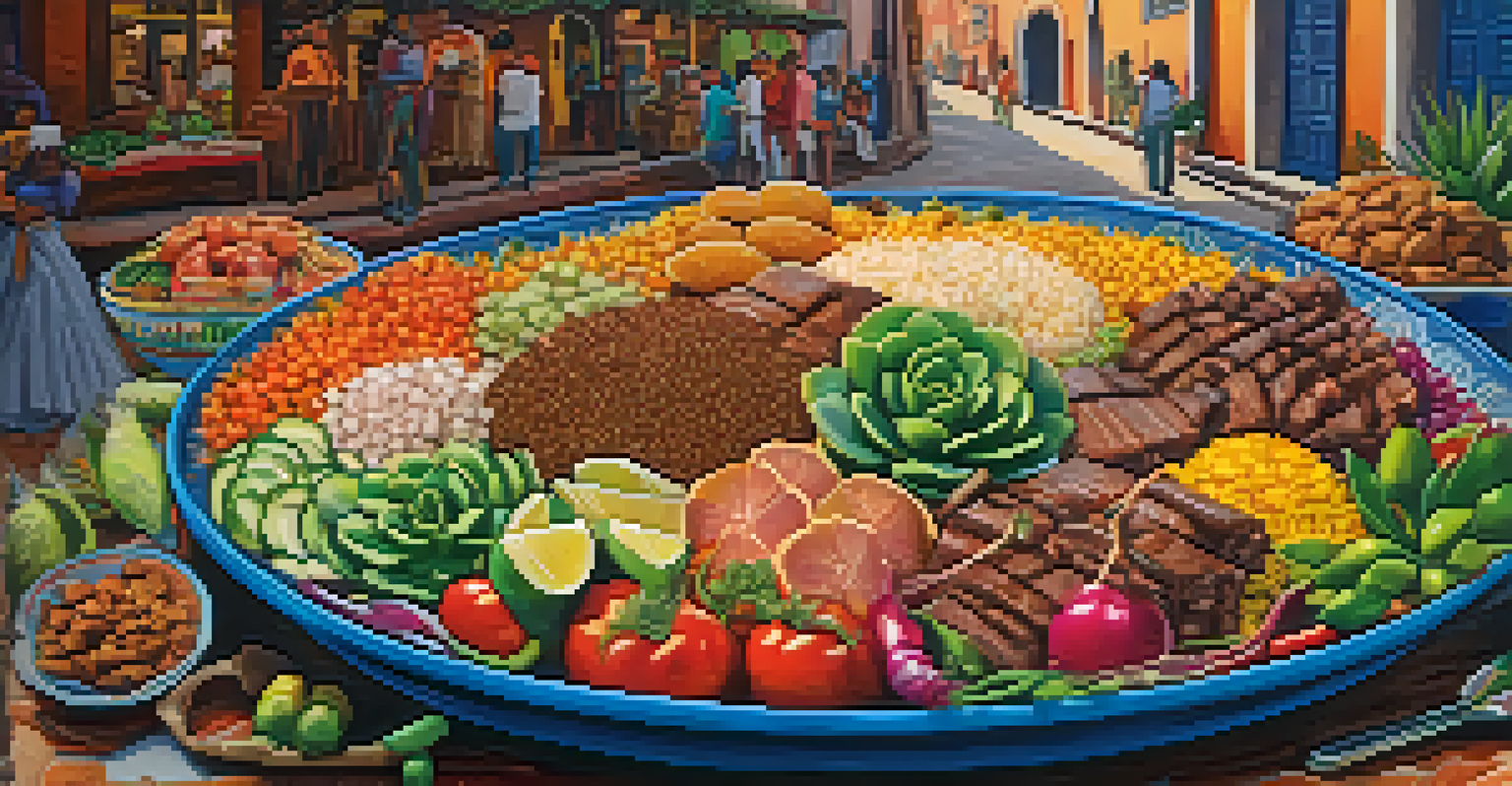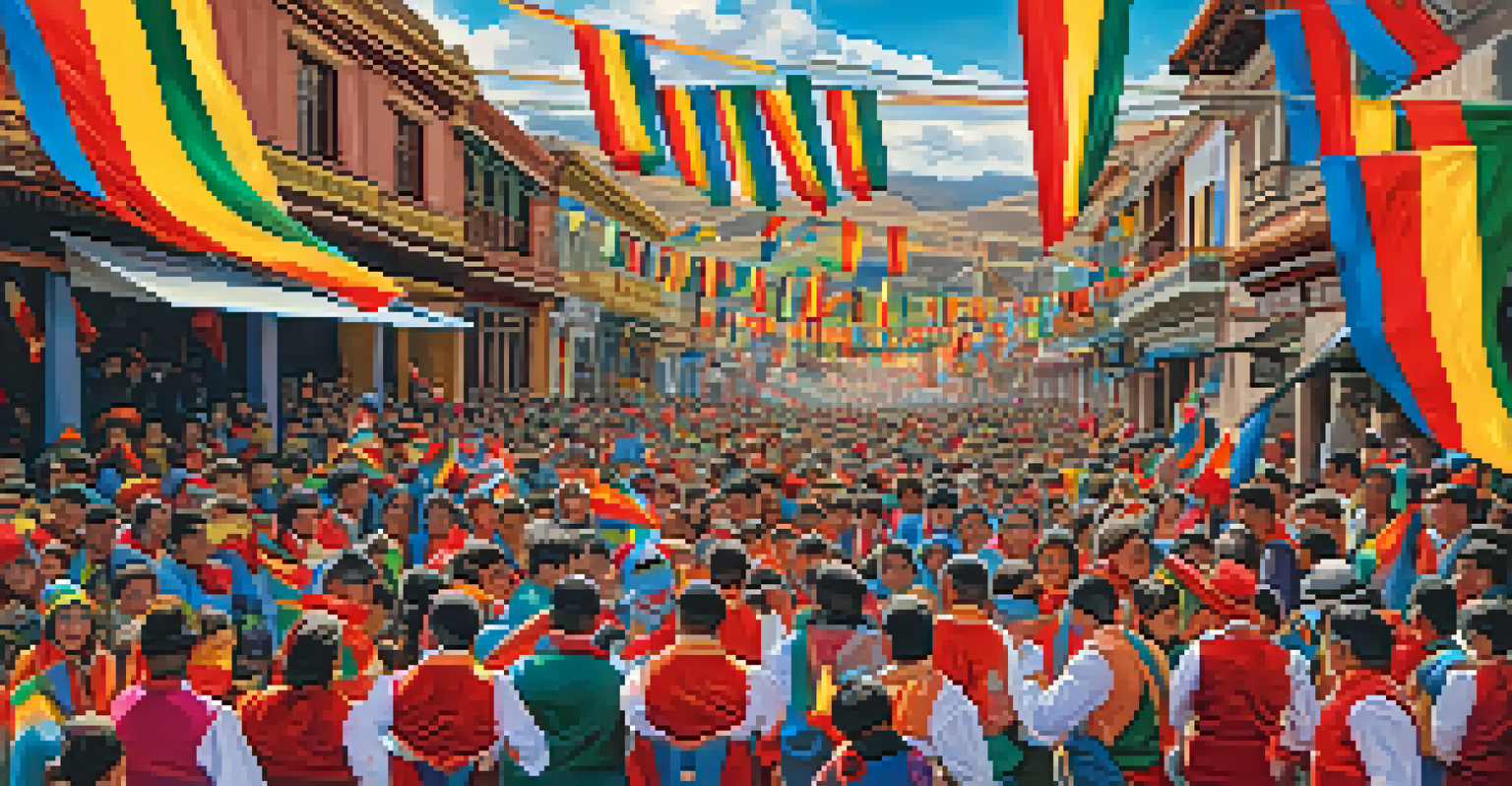La Fiesta de la Virgen de la Candelaria in Puno, Peru

The Origins of La Fiesta de la Virgen de la Candelaria
La Fiesta de la Virgen de la Candelaria, celebrated in Puno, Peru, has deep historical roots dating back to the colonial period. It honors the Virgin of Candelaria, the patroness of the city, who is believed to protect the people and their traditions. This festival is a blend of indigenous and Spanish influences, showcasing the rich cultural tapestry of the region.
Tradition is not the worship of ashes, but the preservation of fire.
Each year, thousands gather to pay homage to the Virgin, participating in a vibrant display of faith and culture. The origins can be traced to the 16th century, when Spanish missionaries introduced Catholic practices to the indigenous people. Over time, locals adapted these beliefs, creating a unique celebration that honors both their heritage and religious devotion.
Today, the festival attracts visitors from around the world, eager to experience the lively atmosphere and colorful traditions. As you walk through the streets of Puno during this time, the blend of music, dance, and spirituality is palpable, inviting all to join in the festivities.
A Joyful Celebration: Key Festivities
The festival, held in early February, lasts for several days and features a variety of events. The most notable include processions, traditional dances, and music performances that showcase the cultural diversity of Puno. Each group that participates in the festival wears vibrant costumes, often adorned with intricate details that reflect their heritage.

One of the highlights is the grand procession where thousands march through the streets carrying the statue of the Virgin. This moment is filled with joy, as dancers perform traditional steps and musicians play festive tunes. The energy is infectious, and you can feel the pride of the participants as they honor their beloved Virgin.
Cultural Roots of the Festival
La Fiesta de la Virgen de la Candelaria is a vibrant celebration that blends indigenous and Spanish traditions, highlighting the rich cultural heritage of Puno.
Additionally, local food stalls offer delicious Peruvian cuisine, allowing visitors to savor the flavors of the region. From hearty dishes to sweet treats, the culinary aspect of the festival adds another layer of enjoyment, making it a feast for the senses.
The Role of Music and Dance in the Festival
Music and dance are at the heart of La Fiesta de la Virgen de la Candelaria, serving as a form of expression and celebration. Traditional Andean music, featuring instruments like the charango and pan flutes, fills the air, creating an uplifting atmosphere. Each musical piece tells a story, often reflecting the struggles and triumphs of the local community.
Food is our common ground, a universal experience.
Dancers, dressed in elaborate costumes, perform a variety of traditional dances, each with its own significance. The 'Diablada,' for instance, represents the eternal battle between good and evil, while the 'Morenada' pays homage to the African roots of the region. Through these performances, participants convey their devotion and cultural identity.
The rhythmic beats and colorful displays of movement draw in onlookers, creating a sense of unity and joy among everyone present. It’s not just a performance; it’s a collective celebration of heritage, faith, and community spirit that resonates deeply with both locals and visitors alike.
The Importance of Community Participation
Community participation is vital to the success of La Fiesta de la Virgen de la Candelaria. Local families, businesses, and organizations come together to plan and execute the various events, demonstrating their commitment to preserving their cultural identity. This collaborative effort fosters a sense of belonging and pride among the residents of Puno.
Many families pass down traditions from generation to generation, encouraging younger members to engage in the festivities. This transmission of culture ensures that the festival remains vibrant and relevant, adapting to contemporary influences while honoring its historical roots. The involvement of the youth is particularly crucial, as it helps to keep these traditions alive for years to come.
Community Involvement is Key
The success of the festival relies on strong community participation, with families and organizations working together to preserve their cultural identity.
Moreover, the festival serves as an opportunity for social cohesion, as it brings people together regardless of age or background. The shared experience of participating in the celebrations strengthens community bonds, making La Fiesta de la Virgen de la Candelaria not just a religious event, but a celebration of collective identity.
Symbols and Icons of the Virgin of Candelaria
The Virgin of Candelaria is not just a religious figure; she is a symbol of hope and protection for the people of Puno. The statue, often depicted with a candle in one hand and the child Jesus in the other, represents light and guidance. This imagery plays a significant role in the festival, as many believe that her presence brings blessings to the community.
During the festival, the statue is adorned with beautiful decorations, including flowers and jewelry, reflecting the love and reverence locals have for her. Many participants make offerings, seeking her intercession for health, prosperity, and peace. This act of devotion is a central aspect of the celebration, reinforcing the bond between the community and their patroness.
Additionally, the symbolism of light is prevalent throughout the festival. Candles are lit in honor of the Virgin, illuminating the streets and creating a warm, inviting atmosphere. This theme of light serves as a reminder of hope and resilience, values that resonate deeply with the people of Puno.
Culinary Delights: Traditional Foods of the Festival
No celebration is complete without delicious food, and La Fiesta de la Virgen de la Candelaria offers a feast for the senses. Traditional Peruvian dishes take center stage, with favorites like 'pachamanca'—a slow-cooked meat dish—and 'anticuchos,' skewered and grilled heart, being widely enjoyed. The flavors reflect the rich agricultural heritage of the region.
Street vendors line the festival routes, serving up a variety of snacks and meals that entice festival-goers. From sweet treats like 'turrón' (a type of nougat) to savory options like 'salchipapas' (fried sausage and potatoes), there’s something for everyone to enjoy. The vibrant atmosphere is complemented by the aroma of freshly prepared food wafting through the air.
Traditional Foods Enhance Celebration
Culinary delights, such as pachamanca and anticuchos, play a vital role in the festival, bringing people together through shared meals and flavors.
Sharing a meal during the festival fosters connections among participants, as food often brings people together. Families and friends gather around communal tables, enjoying the culinary offerings while celebrating their culture and traditions, making the festival a truly enriching experience.
Planning Your Visit to La Fiesta de la Virgen de la Candelaria
If you're considering attending La Fiesta de la Virgen de la Candelaria, planning ahead is essential to fully immerse yourself in the experience. The festival typically takes place in early February, so booking accommodations and travel arrangements in advance is advisable. Puno can get quite crowded during this time, with visitors from all over the world flocking to witness the celebrations.
To fully appreciate the festivities, consider participating in some of the local customs, such as dressing in traditional attire or joining in the dances. Engaging with locals and learning about their traditions can enhance your experience and create lasting memories. Don’t hesitate to ask questions; the people of Puno are known for their warmth and hospitality.

Lastly, be sure to explore Puno beyond the festival. The city is located on the shores of Lake Titicaca, offering stunning views and opportunities for exploration. From boat tours to visiting local islands, you can enrich your trip with a deeper understanding of the region's culture and natural beauty.